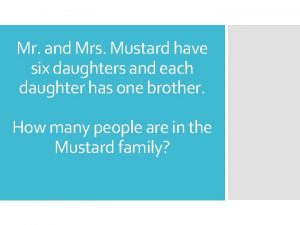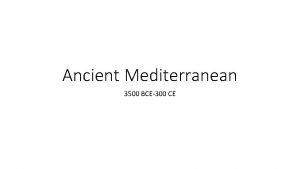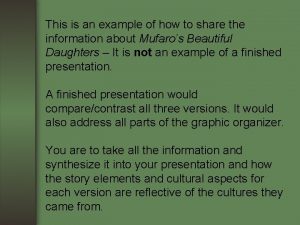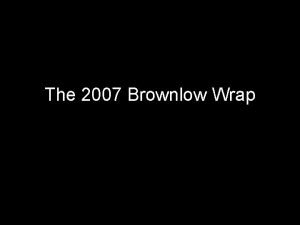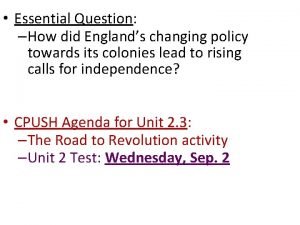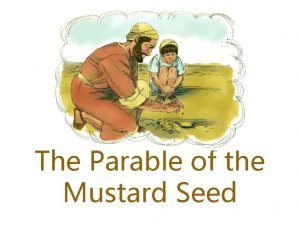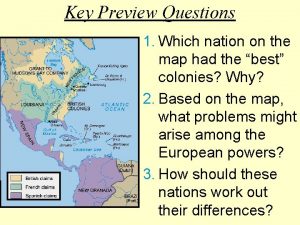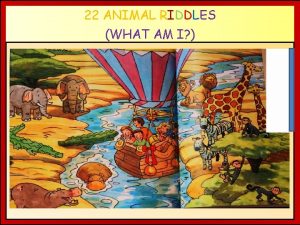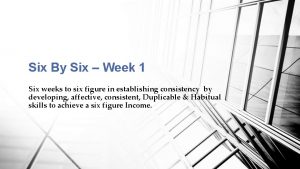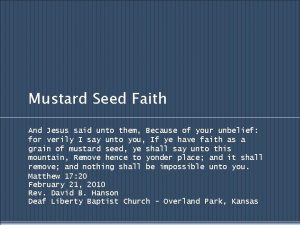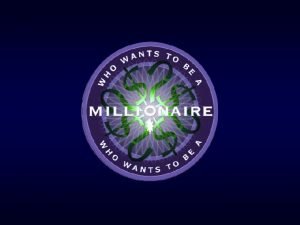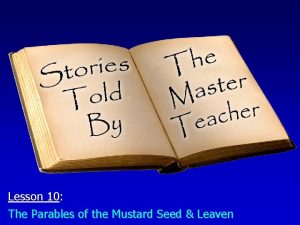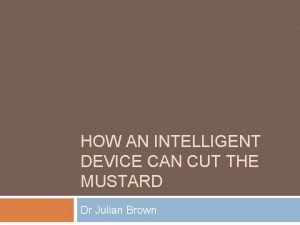Mr and Mrs Mustard have six daughters and


























- Slides: 26

Mr. and Mrs. Mustard have six daughters and each daughter has one brother. How many people are in the Mustard family?

AIMS OF TODAY’S LESSON 1. Understand the Mark Scheme 2. Address any misconceptions OUTCOME OF TODAY’S LESSON 1. Write a to do list that will enable everyone to finish their coursework

Mark Scheme




OVERALL STRUCTURE

QUESTION INTRODUCTION DEBATE + EVALUATE 2 HISTORIANS THEME 1 THEME 2 THEME 3 THEME 4 THEME 5 CONCLUSION ____ BIBLIOGRAPHY HISTORIANS AND 3 PRIMARY SOURCES

TO DO LIST QUESTIONS – FINALISED BY AQA

1. In the context of Germany 1819 to 1945, to what extent was Anti-Semitism amongst the German people, during the years of Nazi Rule (1933 -45) an anomaly? 2. In the context of 1881 to 1982, to what extent was Martin Luther King the most important African. American Civil Rights leader? 3. In the context of 1877 to 1990, to what extent did the Presidencies of Kennedy and Johnson achieve the most significant progress in African American Civil Rights? 4. In the context of 1890 to 2000, to what extent were African American women key in the progress of Black Civil Rights? 5. To what extent did the Supreme Court play a central role in furthering Black Civil Rights in America in the years 1877 to 1980? 6. To what extent did Americas involvement in war play a central role in furthering Black Civil Rights in America in the years 1914 -2016?

TO DO LIST INTRODUCTION

1. If possible, a quote that summarises your argument (historian? ) 2. CONTEXT What is the key debate your question concerns 3. CRITERIA (1) Definition of black civil rights OR anti-Semitism 4. CRITERIA (2) How are you going to judge whether: a) MLK was the most important factor b) Anti-Semitism under Nazi’s was an anomaly c) War had a central role d) Women were key *THIS IS YOUR THEMES + OTHER FACTORS!!!* 5. ARGUMENT What is your answer to the question

TO DO LIST DEBATE

You need to write about the historiographical argument in relation to your questions (i. e. what historians argue) 1. Outline (in as much detail as possible) what different historians argue about your topic (can do more than 2!!). 2. Evaluate the context/limitations of two historians Make sure your historians are DIFFERENT (i. e. not Meier and Carson for MLK because they both write in the 1960/70 s)

TO DO LIST PARAGRAPHS

BEFORE YOU START: 1. Make sure you know what theme requires you to talk about (begin with a definition if necessary) WHEN YOU ARE WRITING EACH THEME: 1. Analyse the factor in your question in relation to theme* 2. Analyse other factors in relation to theme by comparing it to the factor in your Q (to reach the 100 years)* 3. Come to a judgement: answer the question in relation to theme. If you have mentioned any historians, evaluate whether they are convincing. * Embed specific historians views at the beginning of the relevant paragraph and assess whether they are convincing in your analysis. Embed primary sources in the relevant paragraph.

Anti-Semitism Hep-Hep > Kaisers > Weimar > Nazi rule Martin Luther King Booker T Washington, W. E. B du Bois, Phillip A Randolph, Marcus Garvey Martin Luther King; Malcolm X Stokely Carmichael Presidents Hayes > Wilson > Roosevelt > Truman > Eisenhower > Kennedy > Johnson > Nixon > Reagan

You need to be looking at whether Martin Luther King was the key factor in progressing Civil Rights Oratory skills: was MLK a good public speaker? How? Why? What was the impact of this on the progression of civil rights? MARTIN LUTHER KING Planning/organisation: how far was MLK actually planning and organising events? Relations with white people: did MLK get along with white people? How? Why? What was the impact of this on the progression of Civil Rights? Relations with white leaders: did MLK get along with white leaders? How? Why? What was the impact on the progression of Civil Rights leaders Ability to motivate black people: did MLK motivate black people to becoming involved with civil rights? How? Why? What impact did this have on the progression of civil rights?

It is evident that there was massive progress in relation to Civil Rights during the Presidencies of JFK/LBJ, but you need to analyse how far their roles as President influenced this. PRESIDENTS - JFK/LBJ To do this, you need to look at how much power Presidents have. They are part of a wider pollical system (3 branches and check and balances). When Presidents do/do not do something to progress civil rights, is it because of their role as President, or the wider political system they work within? Key things you need to consider: Supreme Court rulings; Congress; issues that states should deal with as opposed to the federal government. What you may notice, is that JFK and LBJ seem to do a lot more for Civil Rights. However when they are President: Plessy vs. Ferguson is overturned in the Supreme Court

You are looking at whether Anti-Semitism under the Nazi’s is different to Anti-Semitism in Germany before Nazi rule… Violence: cause of violence; who was being violent; type of violence; scale of violence Press and Literature: what was being said about Jews; circulation (was anyone reading it); amount of literature ANTISEMITISM Government and Laws: were laws giving Jews more or less rights? Extreme AS groups: Were there Anti-Semitic organisation in German society before the Nazi rule? If so, were there many? How big were they? What were their views? Were people under Nazi rule following orders? Does wearing a swastika and doing a Nazi salute make a German anti-Semitic? How far were German people basing their action on fear/simply following orders (external vs internal anti-Semitism) – Ian Kershaw.

TO DO LIST PRIMARY SOURCES

TONE/EMPHAS PROVENANCE IS CONTENT & ARGUMENT POINT EVIDENCE EXPLAIN What to pick out of the source for the paragraph Own knowledge you have on the points you have picked out Does what you’ve mentioned make the source valuable OR limited. • • Nature/type Author Audience Date/context Language Emotion Views/opinions Details • • Nature/type Who is the author Who is the audience The date/context • Why is the author using this language/emotion? What reaction does the author want? • • Is the author significant/have insight to the topic Is the audience large or significant Does the source give you insight you will not get elsewhere? • Does the tone convey emotion or strength of response to a reaction or event? • Does the content/argument give you insight to the debates and issues at the time? Does the content/argument show you how a person or group perceived the world VIEW POINT ARE VALUABLE • •

TO DO LIST FOOTNOTES

If you use ideas/research from a book/website etc. you MUST use a footnote. If you do not it is plagiarism (and yes, we can tell if you have missed out footnotes). How would you feel if you spent your life researching a topic and developing new perspectives on it, for an 17/18 year old to claim it as their own? You NEED to footnote history books (not just websites, not just history textbooks). Author’s Surname, initial, Book, (year published), page number Author’s Surname, initial, ‘Article title’, Book/publication, (year published), page number Ibid. -Website- [accessed 1 st January 2017]

TO DO LIST BIBLIOGRAPHY

After your piece of coursework, on a separate sheet of paper, you need a bibliography. A bibliography is a list of all the books/website you have used. 1. Divide all of the materials you have used into different sections (books/articles/websites). 2. Order your material in alphabetical order (surname for books/article, webpage for webpage). You can use books you did not end up footnoting in your coursework. Don’t add a load of books you never read, we will know!!
 Mr. and mrs. mustard have six daughters
Mr. and mrs. mustard have six daughters They are mrs garcia and mrs castro
They are mrs garcia and mrs castro They are mrs garcia and mrs castro
They are mrs garcia and mrs castro Mrs. darling was ___________ of mrs. s.
Mrs. darling was ___________ of mrs. s. Akhenaton nefertiti and three daughters
Akhenaton nefertiti and three daughters Classification of rapeseed and mustard
Classification of rapeseed and mustard Daughters of onitah
Daughters of onitah Steve job's daughters
Steve job's daughters Mufaro's beautiful daughters summary
Mufaro's beautiful daughters summary Tomorrow's daughters poem analysis
Tomorrow's daughters poem analysis Job's daughters secrets
Job's daughters secrets Gerard healy daughters
Gerard healy daughters Colonnello mustard
Colonnello mustard Mustard in asl
Mustard in asl No taxation without representation
No taxation without representation A woman mourned by daughters poem
A woman mourned by daughters poem Metaphors about waterfalls
Metaphors about waterfalls Your wives your daughters
Your wives your daughters Mustard agent
Mustard agent Seed
Seed Daughters of liberty
Daughters of liberty Once upon a time there lived a family of bears
Once upon a time there lived a family of bears Daughters of liberty
Daughters of liberty Mustard gas removes guanine from dna
Mustard gas removes guanine from dna Classify each polygon
Classify each polygon A shape with 6 faces and 12 edges
A shape with 6 faces and 12 edges Write four riddles on animals
Write four riddles on animals
